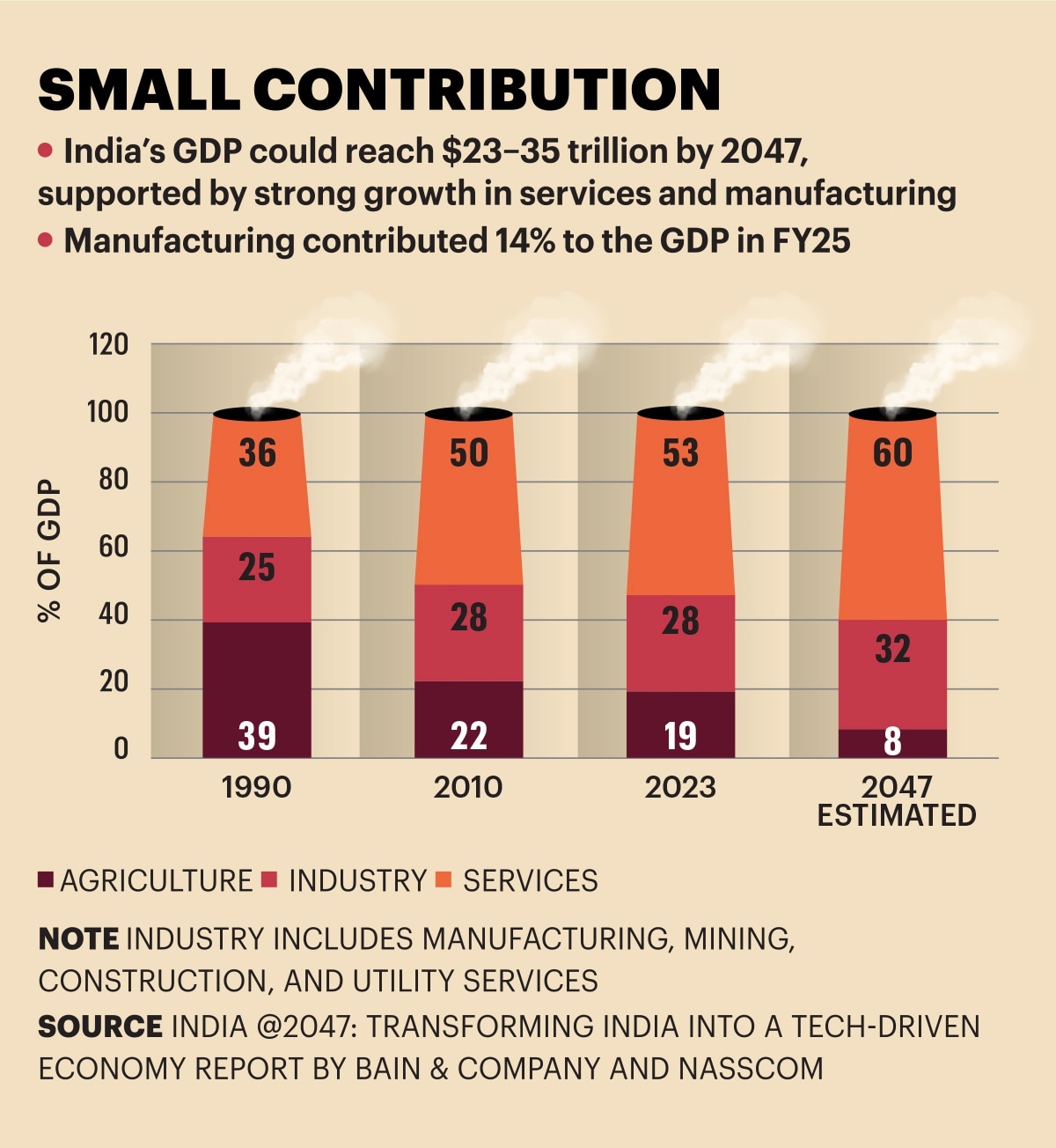

With an estimated gross domestic product (GDP) growth of 6.5% in FY25, India remains the fastest-growing major economy IN THE WORLD. though that rate was the slowest in four years, The good news is that India will retain the fastest-growing large economy tag in the coming years as well with the International Monetary Fund (IMF) pegging its growth at 6.2% in calendar year 2025 and 6.3% in 2026.
As per the IMF, India is set to become the fourth-largest economy this year, overtaking Japan, with experts continuing to bet on its long-term potential. A new report by BofA Securities says nine structural themes beneficial for India’s long-term growth outlook are likely to play out. These are rapid infrastructure build-up; productivity gains through energy efficiency, better logistics infrastructure; improved capital-output ratios; digitisation, financialisation, resilience of household savings; rise in discretionary consumption; formalisation through the goods and services tax (GST); UPI and e-invoicing; decarbonisation; and current account surplus through exports push. “India is likely to become the third-largest economy in the world in this decade, surpassing Germany,” says Amish Shah, Head of India Research at BofA Securities.
But the manufacturing sector remains a concern. Growth in gross value added (GVA) in the manufacturing sector slowed considerably to 4.5% in FY25 from 12.3% the previous year. In FY25, its contribution to overall GVA declined marginally to just 14% from an already modest 14.3% in FY24. In fact, it has been on a downward trajectory in recent years, declining from 17.4% in FY12, despite the government’s ambitions to grow it to 25%.
For comparison, in 2023, manufacturing GVA as a share of GDP was 26% in China and 24% in Vietnam, as per the World Bank data.
Going forward, analysts say this fiscal is likely to remain challenging for the manufacturing sector, in particular, amidst concerns over trade and tariff policies of the US as well as tepid urban demand.

Continuing Fall
Successive governments have adopted a number of strategies to turn India into a global manufacturing hub, but they haven’t been successful in stemming the steady slowdown in manufacturing over the past few decades, even as they shifted focus to a carefully thought-out strategy from the later part of the 1990s to promote the services sector.
As a result, India’s services or tertiary sector accounts for more than half the overall GVA; it contributed 55% of the GVA in FY25. Services exports shot up from $158 billion in FY15 to $387.5 billion in FY24. From 1.9% in 2005, India’s services exports now account for 4.31% of the world’s commercial services exports. In contrast, India’s share in global merchandise exports remained well below 2% at about 1.8% in 2023. China (14.2%), the US (8.5%) and Germany (7.2%) occupy the top three positions in global merchandise exports share.
Of India’s total exports of $824.9 billion in FY25, services comprised nearly 47% at $387.5 billion. A recent report by NSE says India ranks 16th in merchandise exports and seventh in services exports. India’s share of merchandise exports in total exports is 56.2%, much below the global average of 75.3%.
Another report by global investment management firm Omniscience Capital also highlights these challenges, noting that there’s a $3 trillion opportunity in India’s industrial sector by 2035. It points out that industry’s share in the GDP of China, a major export-oriented economy, was 38% in 2023. In fact, for most developed economies, the industry’s share in GDP is much higher than India’s. They also have fewer people engaged in agriculture, the report points out. Industry includes manufacturing, mining, utility services, etc.
The need to push manufacturing has become more urgent in a volatile global economic environment where developments related to trade and tariffs are keeping most countries on the tenterhooks and impacting their growth prospects. Creating adequate employment opportunities for India’s 60 million-plus strong labour force and moving workers from agriculture to more productive and remunerative avenues has also become a key priority for policymakers.
Besides, in light of the rise of protectionism across the world, a key priority of the government has been to turn India into an attractive investment destination for foreign investors and multinational companies.
Schemes such as the flagship Make in India, production-linked incentives and Atmanirbhar Bharat were unveiled to offset the impact of the Covid-19 pandemic and faltering private sector investments due to weak private demand and global uncertainties. Successive Budgets have also announced a slew of measures aimed at reviving the animal spirits of India Inc and attracting foreign investments, which have weakened in recent years with gross FDI inflows falling to $71 billion in FY23 and FY24 from $84.83 billion in FY22 and rebounding only partially to $81 billion in FY25. A more concerning trend has been the drop in net FDI inflows to a mere $0.4 billion in FY25 from $10.1 billion a year ago.
Besides, a full-fledged recovery in private investments remains out of grasp despite India Inc recording strong profits in recent years. The investment growth in FY25 remained robust at 7.1%, though marginally lower than the 8.8% reported in FY24. But it is less than half the average growth of 14.5% during FY05-FY08, says a report by India Ratings and Research.
Experts also point out that in the current period of global volatility, India must build resilience and become self-dependent. Arun Singh, Global Chief Economist at data and analytics firm Dun & Bradstreet, points out that India’s target of becoming a $30 trillion economy by 2047 is huge.

“At this point, where de-globalisation is taking place, creating uncertainty about global trade and economics, India’s core strategy must be to build resilience, but this has to be done through collaboration and not through a policy of isolation,” says Singh.
Ashwani Mahajan, National Co-Convenor of the Rashtriya Swayamsevak Sangh-affiliated economic policy think tank Swadeshi Jagran Manch, also notes that a massive churning is taking place globally and countries are not very happy with globalisation. “In such a scenario, turning Swadeshi is the only way forward,” he says.
“We have to find out-of-the-box solutions and means to build up our manufacturing capability. It has to be a whole of government approach,” says Mahajan. He adds that India needs to manufacture high quality goods to meet the growing aspirations of its 1.4 billion strong population or it risks running a higher trade deficit due to increased imports.
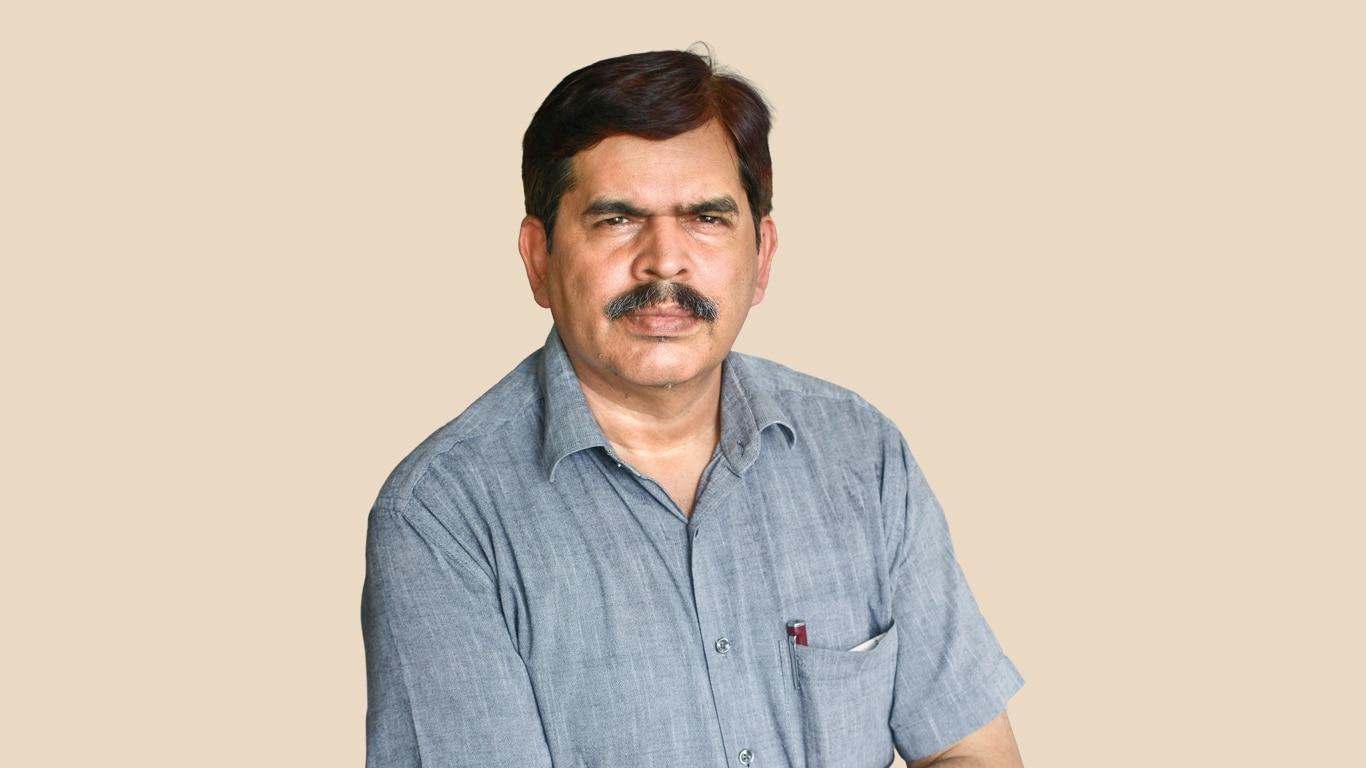
New Frontiers, New Markets
The government is looking at several measures to boost manufacturing and exports, including tapping new markets and some high tech and labour-intensive sectors, where India retains a competitive advantage.
Several building blocks for India’s manufacturing ambitions are in place—whether it is the GST or physical infrastructure through Gati Shakti and the National Industrial Corridors that aim to enhance logistics and make it easier to set up factories.
Policies such as Make in India, PLI, various export incentives and measures to improve ease of doing business have brought in significant interest and investments in sectors like electronics and semiconductors.
For instance, India’s smartphone exports grew by 55% year-on-year (YoY) to $24.14 billion in FY25 from $15.57 billion in FY24, making it the country’s top exported good last fiscal. Overall, India’s electronics goods exports surged 37% YoY to $38.6 billion in FY25, while exports of engineering goods rose by 9.5% YoY to $116.7 billion in FY25. Similarly, drugs and pharmaceutical exports rose 9.3% YoY to $30.5 billion last fiscal.
India’s semiconductor industry is also on the cusp of a breakthrough and Union Minister Ashwini Vaishnaw recently announced that India’s first homegrown semiconductor chip of 28-90 nm is expected to be launched later this year.
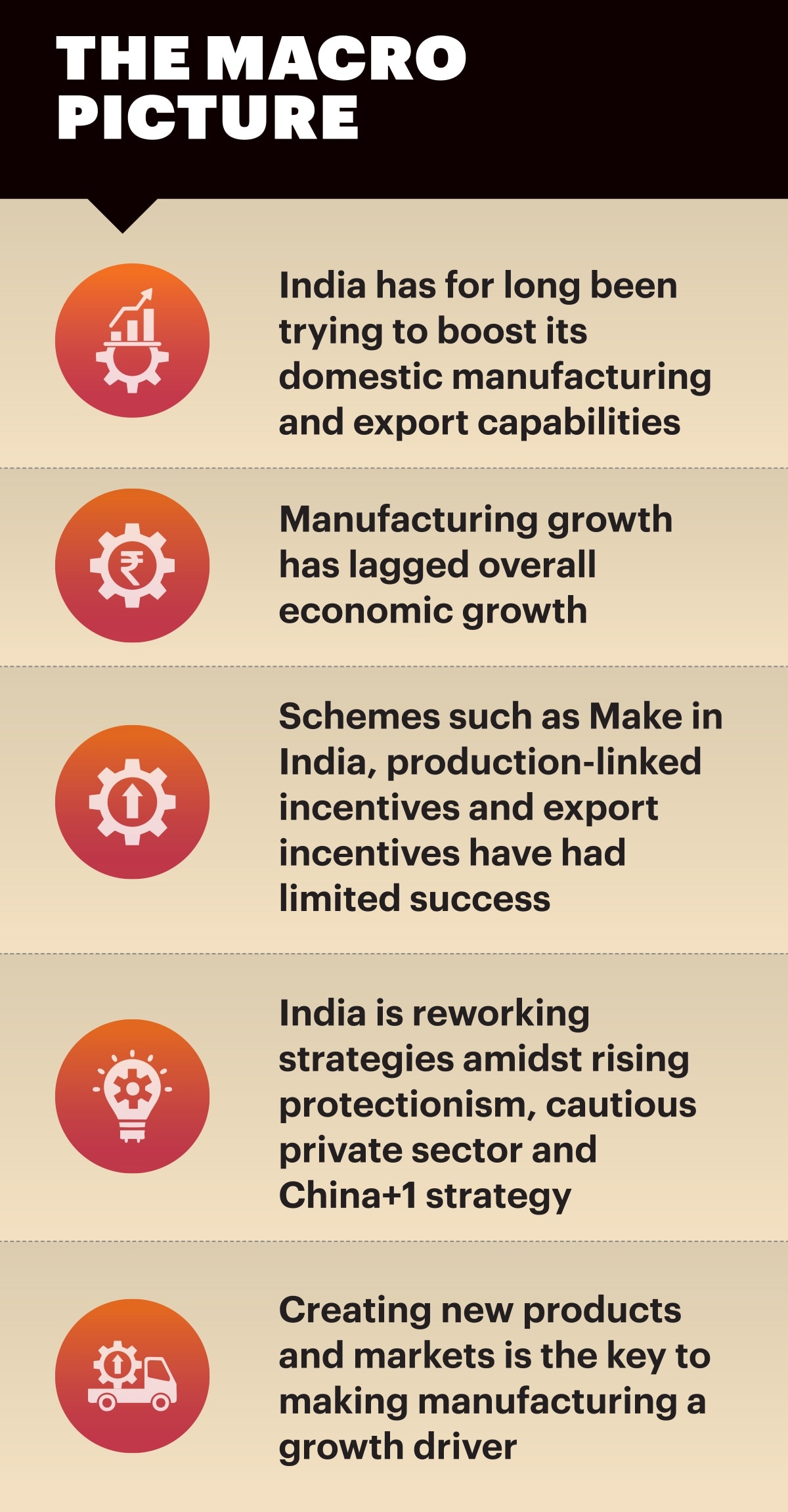
Singh of Dun & Bradstreet notes that the PLI scheme is showing tangible results in manufacturing, especially electronics, with the country turning a net exporter of smartphones. “The momentum has been strengthened with a fresh $2.7 billion allocation announced in March for electronic components, alongside growing foreign investments by firms like PSMC and Foxconn—key steps in India’s semiconductor self-reliance strategy,” he says.
Mahajan also believes that the combination of measures undertaken till now has helped India. “We are now in a situation where we are manufacturing semiconductors. Our chemicals and API industry is bouncing back, defence is doing well and we are even manufacturing electronic goods, albeit with foreign help. A lot of innovation is coming back,” he says.
A recent report by Bain & Company in collaboration with IT industry association Nasscom has outlined a technology road map to position India as a high-income, developed economy by 2047 with a projected GDP of $23–35 trillion.
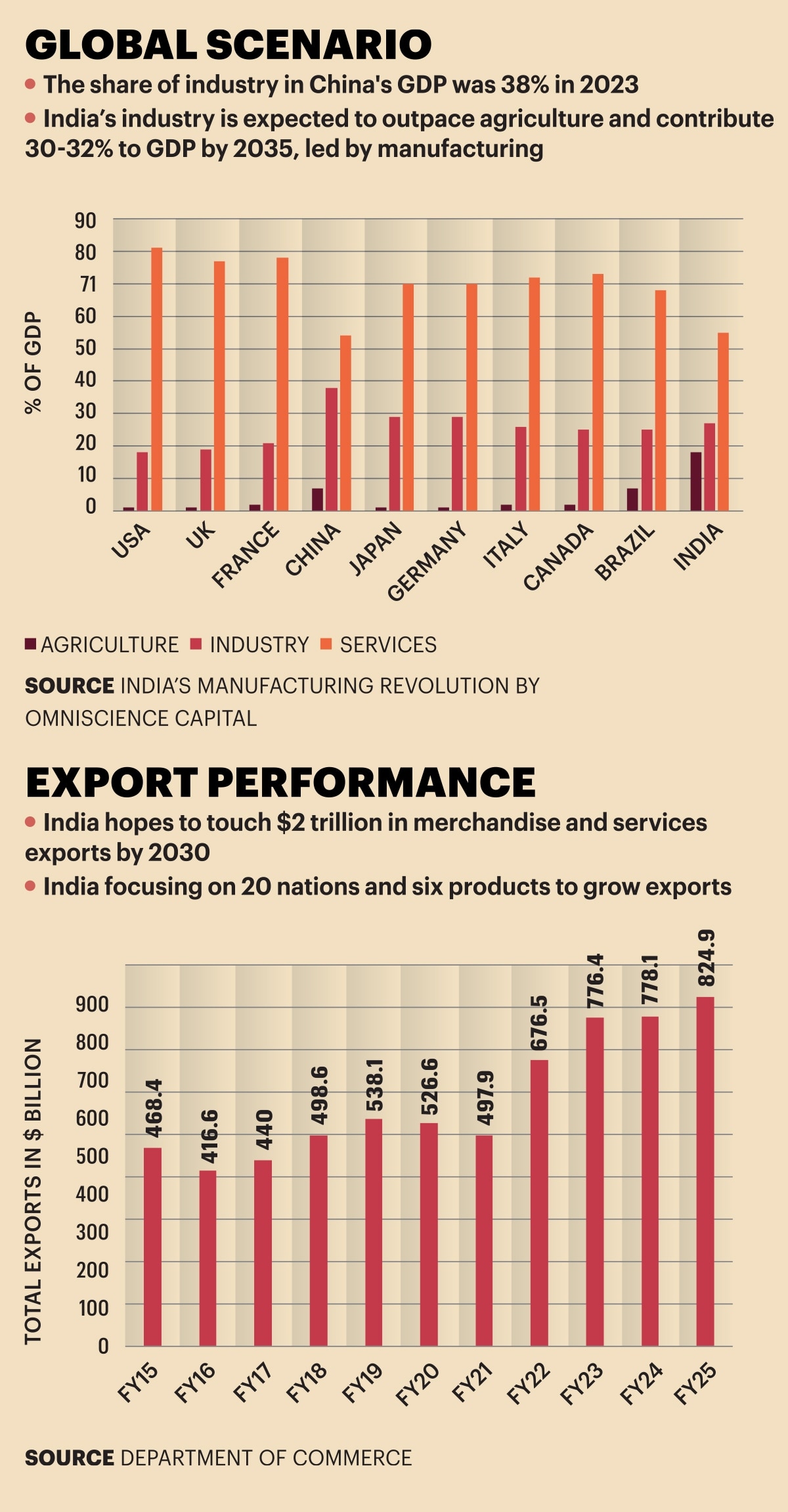
“India will potentially need to make a critical shift, transitioning from a net importer to a globally competitive, export-driven economy, particularly in high-impact sectors such as electronics, chemicals and energy,” says the report, titled India @2047: Transforming India into a Tech-Driven Economy.
Elsewhere, India has turned its attention to critical and rare earth minerals, which have also got engulfed in geopolitical tensions. India has launched a National Critical Mineral Mission (NCMM) to lower its dependence on China, a dominant player in the sector. The recent curbs by China highlight the need for this.
Experts underline that India’s long-term growth priorities rely on building resilience in these areas. A recent report by EY India says that further support from both public and private sectors will be important in this area, adding that strengthening partnerships with countries rich in rare earth elements could also help reduce risks.
The road to self-reliance also depends on building new export markets. India aims to account for 10% of global exports by 2047.
To expand its markets, India has already signed 14 free trade agreements and six preferential trade pacts and is also negotiating several other deals, including those with the European Union and New Zealand. Simultaneously, it is working to diversify its export markets and has a strategy to focus on 20 countries, including Australia, Brazil, China, and France, and six sectors each in commodities and services such as engineering goods, pharma, textiles, IT/ITeS, electronics and agricultural products. Officials say the results have been more than satisfactory so far.
Next Phase Of Reforms
But given the scope of India’s ambitions, it will have to undertake several more measures if it wants to turn its manufacturing sector into a durable engine of growth and enhance its global competitiveness, innovation, and integration into global supply chains.
Singh of Dun & Bradstreet has several suggestions. For one, he says that the continued success of the PLI scheme will depend on building a strong monitoring framework to track progress and refine implementation. As per the last set of data released by the government this March, the scheme, spread across 14 sectors, attracted investments of Rs 1.61 lakh crore and generated sales of Rs 14 lakh crore till November 2024, with significant exports from sectors like large-scale electronics manufacturing, pharmaceuticals, food processing, and telecom & networking products.
He also underlines that to grow its manufacturing, India needs to deepen the ecosystem and incentivise high value manufacturing, like in semiconductors.
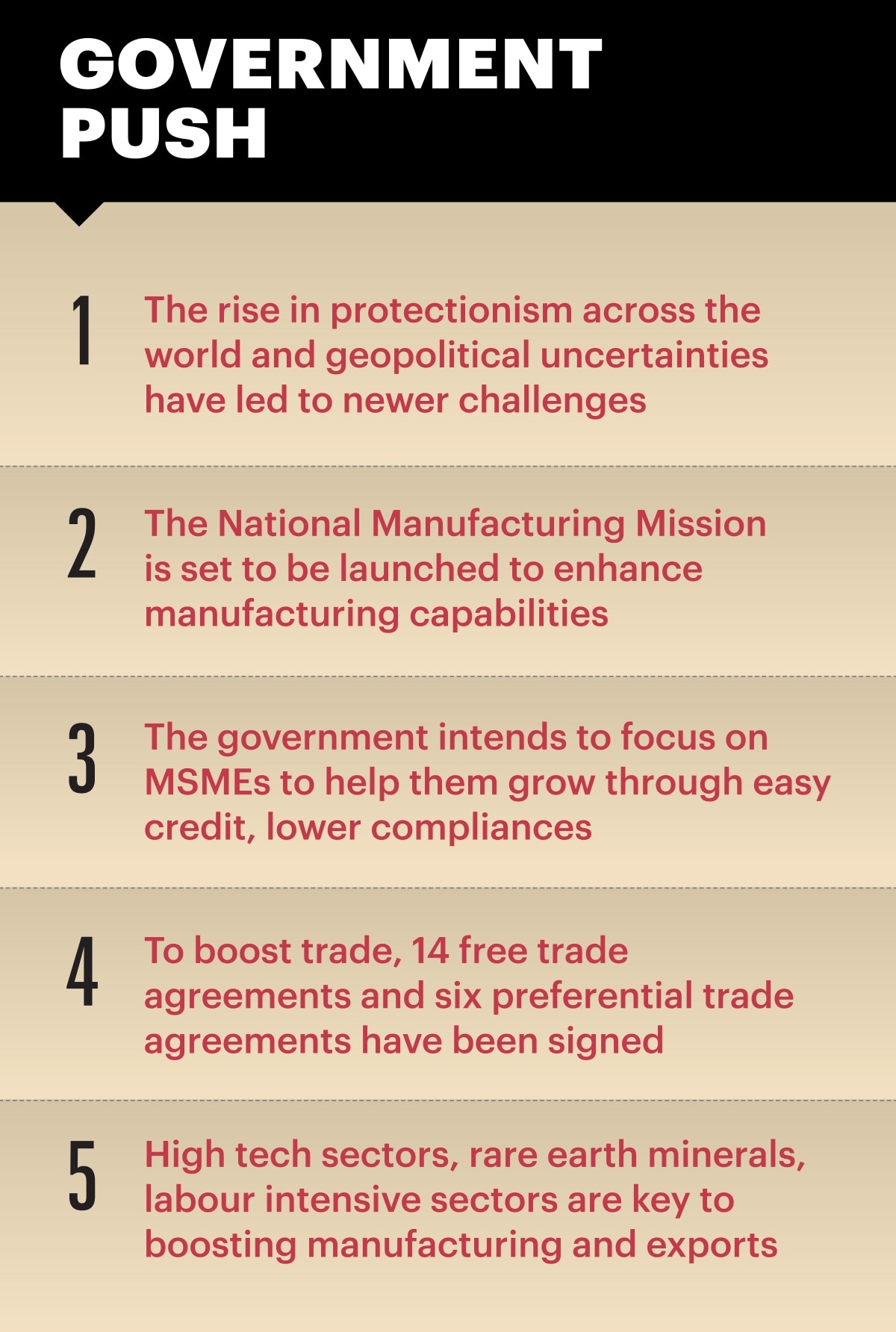
Another important aspect is the integration of MSMEs into the supply chain as they have a huge potential to become growth drivers, he says. In India, 95% of companies are micro, 4% are small and medium sized, and only 1% is large sized. In developed countries, small and medium enterprises account for 40% of companies. “We need to handhold our MSMEs and make them bigger and not just focus on the 1% large companies,” he says.
To empower SMEs, Union Budget 2025-26 also proposed the National Manufacturing Mission, which is expected to be rolled out soon. NITI Aayog CEO B.V.R. Subrahmanyam recently said the mission will serve as an overarching body—one that not only guides and aligns efforts across ministries, but also ensures that all government policies, incentives, and actions work in unison. The deregulation commission proposed by the government in the recent Budget could also give a spur to entrepreneurship, although its modalities are yet to be formally announced.
While the current global volatility has made firms and investors more cautious, India must persevere with measures to grow its manufacturing sector. Several success stories in sectors like electronics, pharma and toys have emerged and others could follow suit, making the manufacturing sector a new sustainable driver of growth.
@surabhi_prasad